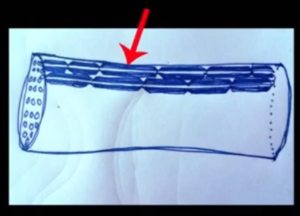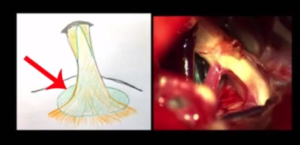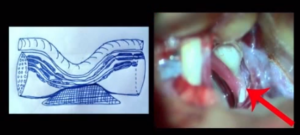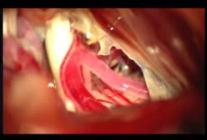One of the most important causes of trigeminal neuralgia is vascular compression of the trigeminal nerve.
What is the main cause of Trigeminal Neuralgia?
One of the most-asked questions in our clinic, when a patient has been delivered the diagnosis of Trigeminal neuralgia is ‘How do you get Trigeminal Neuralgia?’ or ‘ Why did I get Trigeminal Neuralgia?’
The commonest cause for Trigeminal neuralgia is an abnormal contact between a blood vessel (artery, vein or both) and the Trigeminal Nerve, as it exits from the brain. This neurovascular conflict causes the nerve to fire abnormally. It could also result because of aging, multiple sclerosis, or a tumor pressing on the Trigeminal nerve.
How does neurovascular conflict cause Trigeminal Neuralgia?
The nerve is like a phone cable. As you know, a phone cable has insulation from the outside. But inside there are smaller cables tightly packed. Each individual small cable has, in turn, its own insulation and that’s why they cannot normally ‘Cross talk’ with each other. Otherwise an impulse from one cable can short circuit to the other cables.

Similarly, inside the trigeminal nerve, there are smaller nerve fibres. Each one has its own insulation preventing a ‘Cross talk’ between them. The insulation is made up by a substance called the ‘myelin’. The character of this myelin changes at and around the region where the nerve enters in to the brain.

This is called the Root Entry Zone (REZ) Towards the end of the last century, it was discovered that one or more blood vessels compressing this zone (i.e. the REZ) can cause trigeminal neuralgia.

It was postulated and then proven that one or more blood vessels cause severe indentation in the REZ portion of the nerve. Months and years of continuous pulsations against this portion of the nerve damages this portion. This compression seems to cause damage to the myelin, which normally provides insulation to the individual nerve fibres.
What is a Trigeminal Neuralgia attack?

As a result of the blood vessel compressing against the nerve and causing demyelination, the nerve impulses cross fire. A simple ‘touch’ to a portion of cheek or lip or gum gets cross fired and is perceived as sudden, severe sharp pain. This is the classical trigeminal neuralgia ‘attack”.
As is well known, blood vessels in human body ‘elongate’ and harden with age. It is known as the process of ‘ectasia’. In the individuals prone to TN, the vessels originally are in close contact with the nerve. As age advances, they elongate and literally start indenting into and indeed “burying” themselves into the REZ portion of the nerve, causing damage to the myelin and starting the disease process of TN.
In some patients, during the initial days and months of the disease, the body tries to repair this damage by re-forming the myelin. This causes spontaneous disappearance of the attacks-known as ‘Pain holidays’, only to reappear with continued pulsatile compression or ‘hammering’ of the nerve by these blood vessels.
Generally, as the days, months and years pass, the attacks become more severe and more frequent. Subsequently the pain becomes almost continuous. When a small proportion of TN patients with multiple sclerosis or tumours or infarcts is excluded, the remaining majority of the patients get TN due to the blood vessel compression. Rarely, the cause is unknown.
What are Trigger Factors for Trigeminal neuralgia?
Generally, in the initial stages of the disease, the pain attacks are brought on by some triggers. Common trigger factors are touching the face, chewing, brushing teeth, talking, shaving, applying make-up, smiling, washing the face, blow of air on the face, cold weather, etc.
It generally helps to keep a pain diary to keep track of the environment, emotion, activity, with which pain was associated. This helps to highlight common repetitive factors which initiate pain attacks. The specific areas which set off the pain episodes are called trigger zones.
Can the Trigeminal nerve be calmed?
Calming or making the Trigeminal nerve numb is achieved by multiple routes. Medications like anticonvulsants (Carbamazepine), Radiofrequency lesioning, Glycerol injection, Gamma knife radiosurgery etc are all used to decrease impulse transmission in the trigeminal nerve.
However, all of these act like throwing a wet blanket on a raging fire underneath (making the nerve less responsive). Smoke does filter out (break-through pain).
Unfortunately, none of these measures address the root cause of the pain, which is nerve compression by a blood vessel.
The best treatment for Trigeminal neuralgia
The best treatment for Trigeminal neuralgia is therefore the one that addresses the cause- removal of nerve compression. This is called Microvascular Decompression surgery.
Dr Jaydev Panchwagh has performed more than a 1000 operations of MVD in the last two decades.